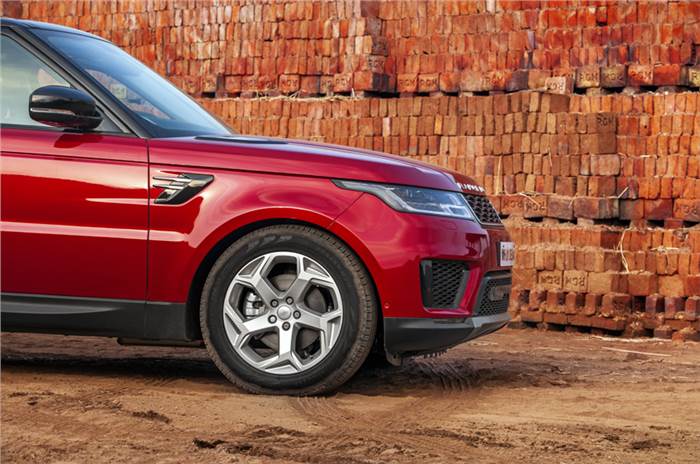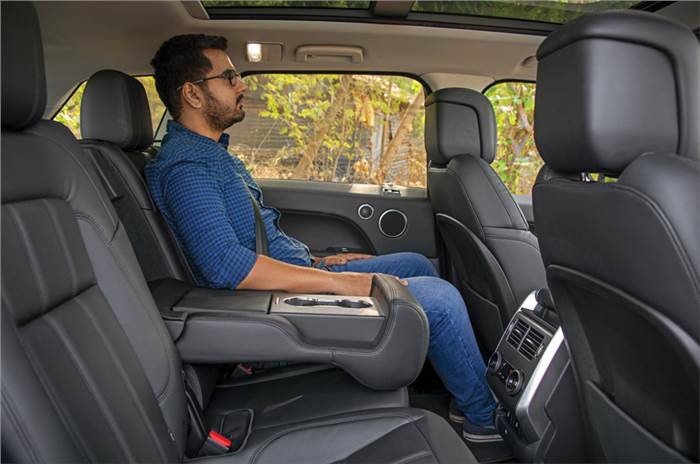Range Rover Sport 2.0 petrol review, test drive
A 2.0-litre petrol engine in a 2-tonne-plus luxury SUV might not sound right. But it works.
Published on Jun 29, 2019 07:00:00 AM
33,736 Views
Follow us on



What is it?
The Range Rover Sport got a facelift last year and this time around it’s in the news for its engine. This new version of the Sport comes powered by a, wait for it, 2.0-litre four-cylinder petrol engine. If you’ve seen a Range Rover Sport in the metal, you wouldn’t be wrong to think that’s too small an engine for so large an SUV. However, this isn’t any other 2.0 unit.

This Jaguar Land Rover Ingenium family engine uses a twin-scroll turbocharger to eke out every last bit of power available. It’s the same engine that powers the base Jaguar F-Type P300. The final power and torque figures stand at 300hp and 400Nm. For reference, the Sport’s supercharged V6 petrol makes 340hp and 450Nm of torque while the V6 diesel is down on power (258hp) but substantially up on torque (600Nm). If anything, the new engine at least deserves a fair hearing.
What's it like to drive?
Leave the engine and 8-speed automatic gearbox to their own devices and you’ll find power delivery to be nice and progressive. The build of speed is friendly, something you’ll appreciate in town. It’s just that when you want that punch, you’ll have to press down hard on the accelerator to get the engine excited. The engine comes into its element after 2,000rpm and there on there’s a constant supply of power till almost 6,000rpm. We registered a 0-100kph time of 8.36sec for the Range Rover Sport. It’s not a shining figure for an SUV with ‘Sport’ in its name but you really won’t find its performance wanting.
| Land Rover Range Rover Sport Price, Mileage, Specifications, Features and Variants | |
|---|---|
| Brand | Land Rover |
| Model Name | Range Rover Sport |
| Land Rover Range Rover Sport Price | ₹ 1.67 - 3.40 crore |
| Land Rover Range Rover Sport Range/Mileage | NA |
| Land Rover Range Rover Sport Specifications | SUV | 5 doors | 5 seats View All Specs |
| Land Rover Range Rover Sport Features | LED headlight | 13.1-inch Touchscreen display | 8 airbags View All Features |
| Land Rover Range Rover Sport Variants | Petrol P400 Dynamic HSE 3.0 | Diesel D350 Dynamic HSE 3.0 | Petrol-Hybrid P460e Autobiography 3.0 View All Variants |

The way the engine sounds is also nice. It doesn’t have the whine of the supercharged V6 or the rorty note of the SVR’s V8 but it’s fun to hear the four-cylinder unit’s soundtrack transition from a muted growl to a louder snarl as you press on. Whoever tuned the acoustics of the engine sure has done a good job. In town too, the engine runs quiet and smooth and overall refinement is not much down on the larger-hearted petrols.
If anything, it’s the 8-speed automatic transmission that fumbles on occasion in low speed settings. It’s a non-issue really and should you want to take manual control of gearshifts, there are paddleshifters and manual shifts at the gear lever too.

In all other areas, this Sport feels like all its siblings (barring the SVR, of course). There’s a lot of roll in the corners and you are always aware that you are driving a large and heavy SUV. On the positive side, there’s a lot of grip at all times (all-wheel drive is standard) and the nicely weighted steering also helps work a good rhythm with the SUV. Particularly good is the Sport’s ride quality. On its 20-inch rims, our test car felt more absorbent than the 21-inch-equipped versions we’ve driven in the past. There is a mild pitter-patter at times; but on the whole, the ride is cosseting to the point you often won’t know how bad the surface beneath you really is. The ability to control the standard-fit air-suspension’s height is also handy, particularly in ingress and egress. You really do need all the help you can get to make your way into this Rangie’s high-set cabin.
What's it like on the inside?
There’s nothing new to report of about this particular Sport’s interior. It’s new-age Range Rover in here with the dual 10.0-inch touchscreen Touch Pro Duo infotainment system being the talking point. The system has been upgraded with Apple CarPlay and Android Auto off late but it’s not its features as much as the interface itself that has divided opinions. The upper screen, adjustable for angle, controls the commonly accessed functions while the lower screen is dedicated to the climate control and off-road mode settings. Frankly, you can get by using the upper screen and voice commands for the majority of functions but, say, when you need to adjust blower speed, you will have to find your way around the lower screen, and this is a distraction. The screens themselves are high-resolution and have fantastic graphics. The digital dials are slick too and you’ll love the touchpads on the steering for the way they look, if not entirely for how well they work.

As ever, you sit high-up in a Range Rover Sport, cabin space is immense and the seats are very comfortable. Land Rover has done away with the option of a third row for India but as a space for five occupants, this interior works really well.

The Range Rover Sport 2.0 Petrol is available in three trims. Air suspension, LED headlights, off-road modes, leather upholstery, reclining backrests for the rear seats and the dual-screen infotainment system are all standard across the board, while a panoramic sunroof is available from the mid-spec SE trim upwards.
Should I buy one?
The 2.0 Petrol is where the Range Rover Sport range starts and there’s really nothing entry-level about the package. It’s quick enough, quiet enough and refined enough to make you think twice about opting for the V6 versions – and that’s even before you bring prices into the equation.

Prices start at Rs 86.71 lakh (ex-showroom, India) for the S trim and top-off at Rs 1.01 crore for the fully-loaded HSE. The mid-spec SE will set you back by Rs 94.49 lakh, which is a full Rs 20 lakh and Rs 25 lakh less than the equivalent petrol V6 and V6 diesel versions, respectively. True, the Range Rover Sport 2.0 Petrol isn’t cheap by any means, but it could just be all the Range Rover Sport you need.
Also see
Click here for all Land Rover models, prices, reviews, images, videos and more
Click here for Land Rover Range Rover Sport prices, reviews, images, videos and more
Tech Specs 
Copyright (c) Autocar India. All rights reserved.












 Price
Price Engine
Engine Transmission
Transmission Body
Body Steering
Steering Dimensions
Dimensions
Comments
Member Login
Personal Details
No comments yet. Be the first to comment.